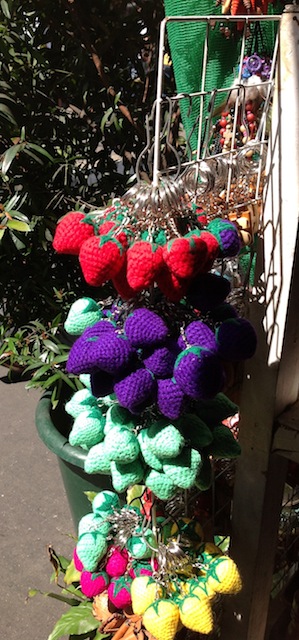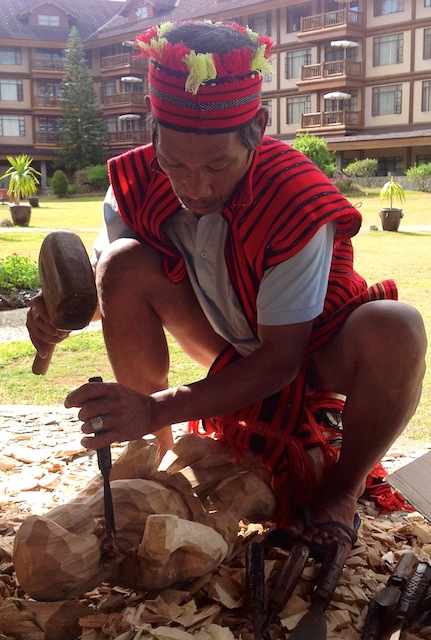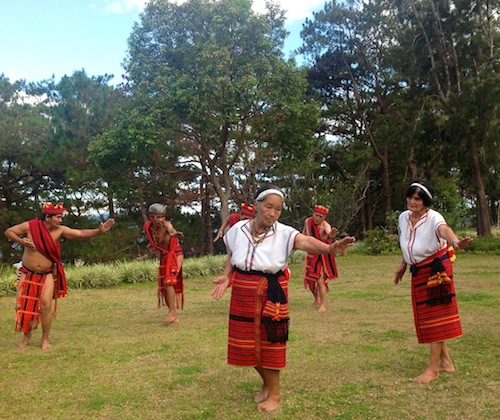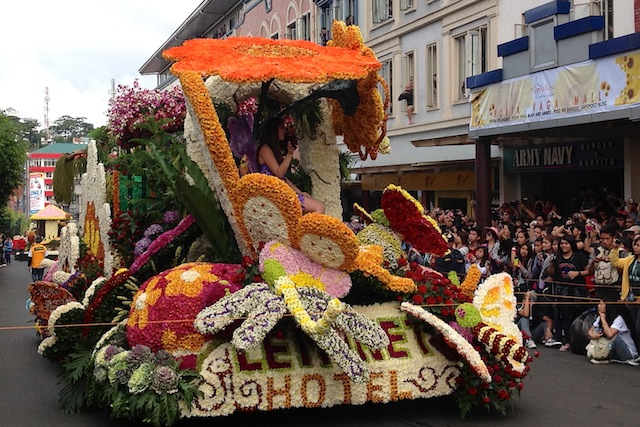Filtered By: Lifestyle
Lifestyle
A weekend of colorful blooms and dances in Baguio's flower festival
Text and photos by YASMIN D. ARQUIZA, GMA News
Three hours waiting at a crowded bus station, the long line of chance passengers playing a game of musical chairs as time passed, was not quite what we expected on our journey to Baguio to watch its popular Panagbenga for the first time. Luckily, the initial torment was worth it, the next three days in the cool highlands providing a much-needed respite from a frazzled lowland existence.
Upon arrival at our hotel room, we were greeted by heaping plates of red luscious strawberries, a much-loved symbol of the city that seemed to be the moti f of our stay. In a fruit shake, a mouthwatering dessert, on the colorful floats, even as souvenir keychains, they were everywhere, ever a reminder of what a treat it was to be in Baguio.
f of our stay. In a fruit shake, a mouthwatering dessert, on the colorful floats, even as souvenir keychains, they were everywhere, ever a reminder of what a treat it was to be in Baguio.
 f of our stay. In a fruit shake, a mouthwatering dessert, on the colorful floats, even as souvenir keychains, they were everywhere, ever a reminder of what a treat it was to be in Baguio.
f of our stay. In a fruit shake, a mouthwatering dessert, on the colorful floats, even as souvenir keychains, they were everywhere, ever a reminder of what a treat it was to be in Baguio. Waking up early on a Saturday morning is not my idea of a relaxing weekend, but we were there to watch a festival so off I dragged my weary bones to the streets after a jolt of caffeine. And that was a good thing, or else I would have missed the array of Cordillera costumes and ethnic rhythms that turned out to be the contest pieces for the street dancing part of the celebration. There were no generic Ati-Atihan moves here, and the participation of many young people—even though some were not as enthusiastic as the others—seemed to spell hope for the future of the Igorot culture.
In the afternoon, we met the women of the Baguio Aquarelle Society, who were holding their second exhibit at the Forest Lodge inside Camp John Hay. Their watercolor paintings adorned the lobby and restaurant of the hotel, mostly refreshing scenes of nature and idyllic country life. Listening to their stories almost makes one yearn to have more of the city’s relaxed pace, if fate would allow it.
 Later, we trooped to the adjoining Manor where a group of Ifugao wood carvers from Hungduan were demonstrating their skills in fashioning rice gods and native huts from aged timber. Visit us along Asin Road, their team leader said, as local artist Ben Hur Villanueva regaled the Manila media with his plans to make the trade more environment-friendly and financially beneficial for the carvers.
Later, we trooped to the adjoining Manor where a group of Ifugao wood carvers from Hungduan were demonstrating their skills in fashioning rice gods and native huts from aged timber. Visit us along Asin Road, their team leader said, as local artist Ben Hur Villanueva regaled the Manila media with his plans to make the trade more environment-friendly and financially beneficial for the carvers. Celebrities and more
The big day, of course, was the float parade on Sunday, Feb. 24. The crowds had grown much bigger compared to the previous day, lining the pavement from the start of the parade route along Upper Session Road all the way to Baguio’s main artery. They were fiercely protective of their reserved positions, hissing at anyone who dared to obstruct their view of the much-awaited main event.
As the PMA band reprised their version of “Gangnam Style,” this time in more relaxed printed shirts and white pants, the audience grew more excited in anticipation of the floats. There were mums, anthuriums, everlasting, carnations, stargazers, a smattering of roses—all creating fantasy worlds filled with insects, animals, huts, brand logos, even a computer icon or two.
But it seemed the crowds were more excited about the celebrities on the floats than the motorized display of flowers, shrieking in excitement and spilling out of the windows as their idols came into view. The stars waved to the huddled audience— Shamcey Supsup, Gary Valenciano, Robin Padilla, the cast of epic serye Indio, among others—while Daniel Matsunaga shook hands with fans along Session Road.
At a news conference later, Rep. Bernardo Vergara said more than two million visitors came for Panagbenga this year, more than in previous years, citing police estimates. He expects more tourists to come once the expressway connecting Manila to Rosario, La Union is completed, as planned, by May 2014; this is supposed to cut down the travel time to Baguio to only three hours.
Although he praised this year’s festival as “the most organized, most peaceful, most clean Panagbenga ever,” a minor explosion near Burnham Park did create a sore note for the event. Organizers were quick to downplay it as an isolated incident, with Panagbenga 2013 co-chairman Anthony de Leon describing it as “an accident inside the office of anti-crime volunteers, who were playing with something they shouldn’t be playing with.” Three people were injured in the blast.
Choreography and culture
For the benefit of Panagbenga first-timers, Mayor Mauricio Domogan recalled the goals of the festival: to give thanks for nature’s bounty, unite the people of Baguio, sustain the tourism industry, and promote the culture of the Cordillera region.
The last goal was in much evidence during the street performances, with the men proudly wearing the G-string and the women dancing in newly woven skirts that vary in design from one tribe to the next. Domogan says dialogue with various groups is bringing a revival of local traditions, and festival participants are conscious about the correct way of dancing and playing Igorot music.  “Choreography has to follow culture,” he said. For instance, banging of gongs should be done properly in order to convey the intended meaning and not misinterpret the dance, Domogan said.
“Choreography has to follow culture,” he said. For instance, banging of gongs should be done properly in order to convey the intended meaning and not misinterpret the dance, Domogan said.
 “Choreography has to follow culture,” he said. For instance, banging of gongs should be done properly in order to convey the intended meaning and not misinterpret the dance, Domogan said.
“Choreography has to follow culture,” he said. For instance, banging of gongs should be done properly in order to convey the intended meaning and not misinterpret the dance, Domogan said. “We put a premium on culture as far as street dancing is concerned,” added Freddie Alquiros, chairman of Panagbenga 2013. He credited the Baguio Cultural Society for introducing a regional flavor to the festival three years ago, with participants from as far as Tabuk now sharing their folk tales through dance.
With elections just three months away, the organizers had to issue strict guidelines to participants not to throw souvenir items to the crowd or campaign for their candidates. “We were successful in discouraging politicians from taking advantage of the festival,” de Leon said, and indeed there was little sign of campaigning during the parade, at least from our media group’s vantage point near the cathedral.
Flower market
So what happens to the flowers afterward, I wanted to know, wondering about the fate of all those beautiful blooms. The major criteria for the floats is that 95 percent should be decorated with flowers, and this year, judges from the World Flower Council proclaimed the whimsical garden created by Le Monet hotel as the winner. “We use them as compost,” came the practical answer from de Leon. 

Heiner Maulbecker, managing director of The Manor at Camp John Hay that hosted the media group from Manila, suggested a permanent flower market in Baguio that would allow visitors to enjoy the city’s blooms not just during the festival but all year round.
That’s one idea that the Panagbenga Foundation might take up, Alquiros mused. For now, he says, they’re already planning a “bigger and grander” festival for the 20th Panagbenga in 2015, just in time for the hordes of tourists coming up through the expressway to Rosario by then.
The last week of the month-long Panagbenga festival, which ends Sunday, is devoted to Session Road in Bloom. The entire stretch is closed off to vehicles and gives way to rows of shops and cafes, as pedestrians reclaim Baguio’s main street. Before heading back for Manila, we piled our shopping bags with highland coffee, mountain rice, and strawberry jam to remind us of the trip that will surely not be the last. —KG, GMA News
More Videos
Most Popular




